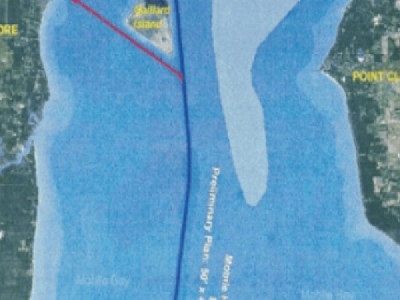
Posted on October 9, 2018
The Army Corps of Engineers is considering expanding the area where “beach quality” material is disposed from its dredging activities in Mobile Bay, but some Dauphin Island residents are concerned the change still won’t fix their problems with erosion.
As Lagniappe has reported, the Corps recently ended the public comment period for the draft version of a Supplemental Environmental Impact Statement (SEIS), part of a larger evaluation of the impacts of deepening and widening the Mobile shipping channel.
The tentatively selected plan would deepen the 36-mile channel to an overall depth of 50 feet and widen a three-mile stretch in the lower part of the bay, among other expansions — all of which would mean a permanent increase in the Corps’ routine maintenance dredging in the bay.
That’s a concern for property owners on Dauphin Island, many of whom have argued for years that the Corps’ dredging activities disrupt the natural flow of sediment and prevent sand from reaching the island.
While the draft SEIS acknowledges “channel dredging disrupts the sediment transport to Dauphin Island,” the Corps maintains that routine maintenance dredging in the bay does not significantly contribute to erosion on Dauphin Island.
The SEIS states the proposed channel expansion would have only a “minimal” impact as well.
Since 1999, the Corps has deposited “beach quality” dredge material in the Sand Island Beneficial Use Area (SIBUA) southeast of Dauphin Island. Yet many residents, including Mayor Jeff Collier, say those sands are not joining the littoral system fast enough to nourish the ailing island.
Collier and others have long advocated for a disposal site in shallower waters closer to the shoreline.
“Much of the dredge material, especially the beach quality sands found in the outer bar portion of the channel, are an extremely valuable resource and should be treated as such,” Collier wrote in an open letter to citizens last month. “For decades, millions of cubic yards of pristine sand has been transported far offshore where it is essentially dumped as ‘yesterday’s trash’ and removed from the littoral system that would otherwise feed downdrift areas including Dauphin Island.”
The Corps has previously rejected the idea of disposing of high-quality dredge materials in shallow waters because it would require the use of specialized equipment and increase the expense of routine channel maintenance that already costs millions of dollars annually.
The Corps is now considering an expansion of the SIBUA, though Cesar Yabor, a spokesperson for the Mobile District, said those considerations are not motivated by the ongoing harbor evaluation or concerns raised about erosion on the island.
“The Corps has proposed extending the [SIBUA] to the northwest in order to ensure placement capacity for future maintenance material dredged from the bar channel,” Yabor wrote via email. “Based on the analysis completed as part of this study, the proposed northwest extension should facilitate movement of placement material along the shoal.”
That proposal, which has yet to be approved, permitted or funded, would expand the SIBUA approximately 3,305 acres to the northwest — putting it closer to Dauphin Island and increasing the disposal capacity for the Corps.
Still, many residents remain skeptical of the Corps’ promises and intentions. Glen Coffee, a former Corps biologist himself, has led an organized effort to address the Corps’ impact on the erosion of Dauphin Island for years. He told Lagniappe in September that the Corps hasn’t provided any information to suggest expanding the SIBUA would have any direct benefits for the island.
He also noted the SIBUA has been expanded before.
“That site was established in 1999 to do what they say it’s going to do now with an expansion, but it was expanded to the south in 2009 and that didn’t work either,” Coffee said. “They’re also not doing this to do a good thing. They’re doing it because [SIBUA] is filling up to the point their hopper dredges can no longer work there.”
It is true the SIBUA is reaching capacity. In fact, a Corps survey conducted earlier this year determined the site is “inadequate using current placement practices” and the SEIS itself acknowledges that sand is moving out of the area at half the rate it’s being placed there.
The Corps says sand is moving toward Dauphin Island already, but slowly. Coffee argues the sand it isn’t moving at all and pointed to the fact that the SIBUA has continued to fill up over the entire 19 years of its existence.
He and others have suggested the Corps instead place beach quality dredge material in waters less than 15 feet deep and closer to Pelican Island, where Coffee believes it would naturally move were it not for the Corps’ interference.
Coffee estimates around 7 million cubic yards of sand has been prevented from reaching Dauphin Island naturally since 1999. As a result, he’s advocated for the use of RESTORE Act money to dredge the SIBUA and transport the material closer to Dauphin Island.
The Corps has given no indication it would consider such a proposal, which would likely cost millions of dollars to implement.
As for the proposed expansion of the SIBUA, Yabor said there are still several steps to complete, including evaluations by a number of federal and state agencies.
Collier, who says he supports the expansion of the shipping channel because of its importance to the state economy, said he would also like to see the ongoing evaluation include a “more responsible and truly beneficial dredge disposal practice.”
“To put it quite simply, the channel regularly fills with sand it doesn’t need and Dauphin Island, a mere stone’s throw away, is sand starved,” Collier wrote. “Surely we can figure out a way to ‘connect these dots.’”
Source: Lagniappe





